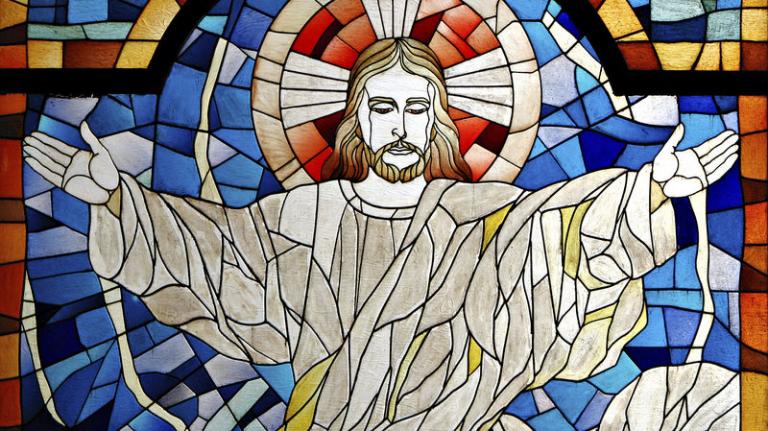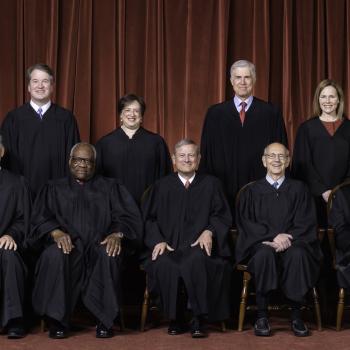 Some rationalists might say, “If I could see a miracle, I’d believe in the supernatural.” Or some skeptics might say, with Easter now near, “If I could have seen Jesus alive, I would have believed in his resurrection from the dead.” Yet, Jesus said multiple times, “An evil and adulterous generation seeks after a sign” (Matthew 12.39; 16.4), that is, in order to believe in the supernatural. And when doubting Thomas saw the risen Jesus, with the holes in his wrists and the hole in his side due to the crucifixion, and then he believed, we read in the Gospel of John, “Jesus said to him, ‘because you have seen Me, have you believed? Blessed are they who did not see, and yet believed'” (John 20.29). That refers to all of us who will soon celebrate Jesus’ literal resurrection from the dead.
Some rationalists might say, “If I could see a miracle, I’d believe in the supernatural.” Or some skeptics might say, with Easter now near, “If I could have seen Jesus alive, I would have believed in his resurrection from the dead.” Yet, Jesus said multiple times, “An evil and adulterous generation seeks after a sign” (Matthew 12.39; 16.4), that is, in order to believe in the supernatural. And when doubting Thomas saw the risen Jesus, with the holes in his wrists and the hole in his side due to the crucifixion, and then he believed, we read in the Gospel of John, “Jesus said to him, ‘because you have seen Me, have you believed? Blessed are they who did not see, and yet believed'” (John 20.29). That refers to all of us who will soon celebrate Jesus’ literal resurrection from the dead.
Jesus resurrection is particularly of interest to me. I believe if Jesus had not risen from the dead and showed himself to his disciples, there never would have been any Christianity. That caused Jesus’ disciples to go into many parts of the world and preach about this no matter what the cost to themselves. Indeed, tradition says that most if not all of Jesus’ apostles, with the possible exception of the Apostle John, became martyrs for their faith in Jesus. This interest in Easter caused me to write a screenplay about Jesus’ resurrection that is based mostly on portions of my first book, The Gospels Interwoven. It is the only movie script I’ve written.
Since Easter is right around the corner, the title of this post is a timely question. The right answer is that it depends on who we ask. If we had asked Mary Magdalene, “who was the first to believe that Jesus had risen from the dead?” she would have answered that she was. She would have been correct. However, she actually saw and conversed with the risen Jesus. Whereas, if we had asked another one of Jesus disciples, he would have answered that he was a little more like us in being the first to believe in the risen Jesus even though we didn’t see him alive when we believed. It’s all about evidence.
Here’s what happened, according to the New Testament gospels, several women on early Sunday morning had gone to the graveyard at Golgotha to further anoint Jesus’ body, in accordance with Jewish custom. His deceased body was entombed and laying on a shelf in that cave-tomb (Luke 24.1, 10). But the women discovered that Jesus’ body was not there. Then, two angels dressed in bright-shining, white clothing appeared to them inside the tomb. They told these ladies that Jesus had risen from the dead. And these angels reminded them that Jesus earlier had predicted to them that this is exactly what would happen (e.g., Matthew 16.21; 17.22-23; 20.18-19). Then they told the women to go tell his disciples, even mentioning specifically Peter, to tell them. So, the women fled and went to do so.
Then we read of Mary Magdalene, “And so she ran and came to Simon Peter, and to the other disciple whom Jesus loved [probably the Apostle John, which is according to Christian tradition], and said to them, ‘They have taken away the Lord out of the tomb, and we do not know where they have laid Him'” (John 20.2). What! The two angels had just told Mary and the other women that Jesus had risen from the dead. So, at this point we cannot accept that Mary Magdalene was a full believer in Jesus’ resurrection. But it was the same with the men. For Luke tells us that when the women told the male disciples about the missing body and what the angels had told them, “they were Mary Magdalene and Joanna and Mary the mother of James; also the other women withthem were telling these things to the apostles. And these words appeared to them as nonsense, and they would not believe them” (Luke 24.10-11). So much for the gender thing!
The Gospel of John then tells us, “Peter therefore went forth, and the other disciple, and they were going to the tomb. And the two were running together; and the other disciple ran ahead faster than Peter, and came to the tomb first; and stooping and looking in, he saw the linen wrappings lying there; but he did not go in. Simon Peter therefore also came, following him, and entered the tomb; and he beheld the linen wrappings lying there, and the face-cloth, which had been on His head, not lying with the linen wrappings, but rolled up in a place by itself. So the other disciple who had first come to the tomb entered then also, and he saw and believed. For as yet they did not understand the Scripture, that He must rise again from the dead. So the disciples went away again to their own homes” (John 20.3-10). “The disciples” refers to Peter and (probably) John.
The word “homes” in John 20.10 appears in every modern, major, English version of the New Testament (“own home” in KJV) despite the fact that it is not in the Greek text (Nestle Aland 28th ed; United Bible Society 4th ed.). It should not be added. Instead, Peter and John (probably) likely returned to their home where they were staying. Christian tradition says the two brother apostles, James and John, owned a home in Jerusalem, besides their home in Capernaum on the Sea of Galilee, because they were commercial fishermen, as were brother Andrew and Simon Peter, and they traveled back and forth to sell their salted fish in the Jerusalem markets (Mark 1.16-21). That is may be why the Apostle John obviously knew some of the members of the Sanhedrin–the Jewish Council that condemned Jesus to death.
Why does John 20.8 say the Apostle John (assuming the beloved is him) “saw and believed” that Jesus had indeed risen from the dead? It was because of the evidence of Jesus’ resurrection which he had just seen–“the face-cloth, which had been on His head, not lying with the linen wrappings, but rolled up in a place by itself.” John must have realized that no one would steal a dead body by first removing the grave cloths and folding the face-cloth and laying it on the shelf where the body had laid. Why not?
Israel was not a sovereign state. In fact, the land of Israel was the only territory within the confines of the Roman Empire that was not part of the Roman Empire. Thus, Israeli Jews were not Roman citizens. It was because the Romans viewed Jews as a rather odd bunch, what with the strange way that they dressed and their unusual dietary laws, all due to their religion. Moreover, many Roman citizens viewed Jews and subsequent Christians as atheists because they did not believe in, or worship, the Roman gods at their shrines. Romans viewed that as disruptive to pax Romana.
So, the Roman Empire, like many ancient societies, protected religious shrines and honored human burial grounds and the remains inside of them. Thus, it was a capital crime deserving of death to desecrate religious shrines or graveyards or steal human remains from the latter. Thus, if anyone had stolen Jesus’ body from the tomb, and been apprehended, that person likely would have been executed by the state.
So, a wise thief would not have taken all of that time to strip Jesus’ body and nicely roll up the face-cloth, thus further risking getting caught. And the theory of skeptics, that the gardener had removed Jesus body to another location within the graveyard, as Mary originally had thought, is most unlikely because the gardener certainly would not have removed the grave cloths, since they with the 100 pounds of spices mixed within them were for the purpose of preserving the body as long as possible from decay. The nearby Egyptians were famous for doing that with mummification.
Apparently, when Mary Magdalene had told Peter and John about the missing body, and they ran to the tomb, Mary then left the house and followed them back to the tomb. But she very likely had no need to run there. Thus, by the time she arrived at the tomb for the second time that morning, both Peter and John had left the tomb.
Thus, we read in the Gospel of John, in John 20.11-18 in the NASB, “But Mary was standing outside the tomb weeping; and so, as she wept, she stopped and looked into the tomb; and she beheld two angels in white sitting, one at the head, and one at the feet, where the body of Jesus had been lying. And they said to her, ‘Woman, why are you weeping?’ She said to them, ‘Because they have taken away my Lord, and I do not know where they have laid Him.’ When she had said this, she turned around, and beheld Jesus standing there, and did not know that it was Jesus. Jesus said to her, ‘Woman, why are you weeping? Whom are you seeking?’ Supposing Him to be the gardener, she said to Him, ‘Sir, if you have carried Him away, tell me where you have laid Him, and I will take Him away.’ Jesus said to her, ‘Mary!’ She turned and said to Him in Hebrew, ‘Rabboni!’ (which mean, Teacher). Jesus said to her, ‘Stop clinging to Me, for I have not yet ascended to the Father; but go to My brethren and say to them, “I ascend to My Father and your Father, and My God and your God.”‘ Mary Magdalene came announcing to the disciples, ‘I have seen the Lord,’ and that he had said these things to her.”
Because of this, in Christian tradition Mary Magdalene has been called, to the delight of Christian womenfolk, “the Apostle to the Apostles.” Indeed, but was it not easier for Mary Magdalene to believe in the risen Jesus than it is for us? After all, she got to actually see the risen Jesus close-up and have a rather sublime conversation with him.
I think the Apostle John would back us up on that assessment due to his experience. He did not get to see the risen Jesus until that evening, when the disciples were gathered together, probably in the Upper Room. That is where they had celebrated the Last Supper on Thursday evening, the night before Jesus was crucified. Yet John had believed that morning when he saw the evidence of the grave cloths and face-cloth, indicating that Jesus had indeed risen from the dead.
Thus, there is much solid evidence that Jesus of Nazareth literally arose from the dead. And I believe that to ignore such solid evidence of Jesus’ resurrection as rationalists and skeptics do–in which God revealed himself through the man Jesus–is to do so at one’s own peril.
[Click here for my post on the Shroud of Turin not being Jesus’ burial cloth and here for Jesus’ resurrection appearances not being visions.]












